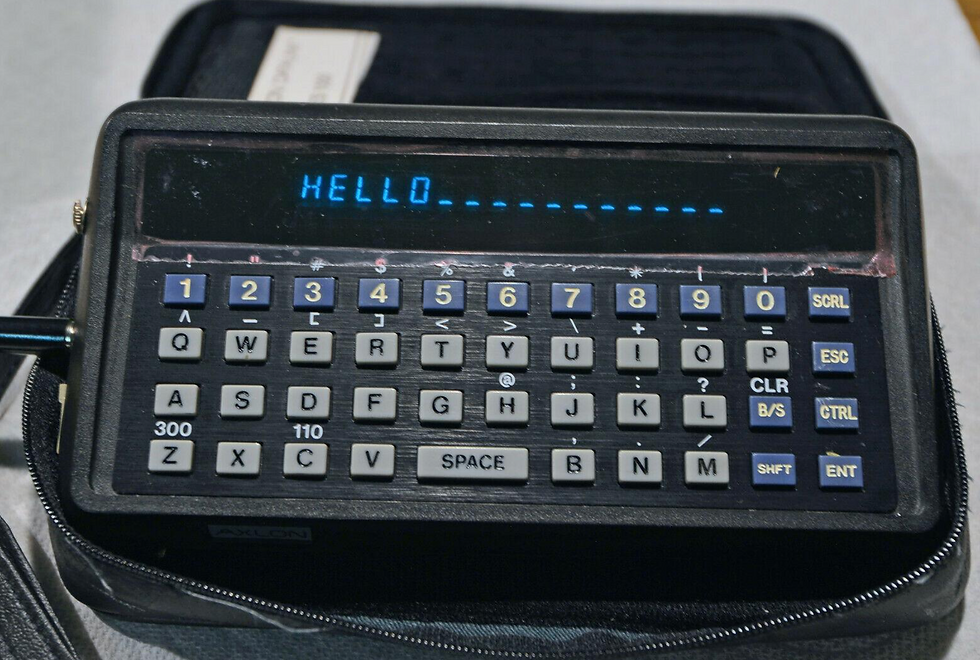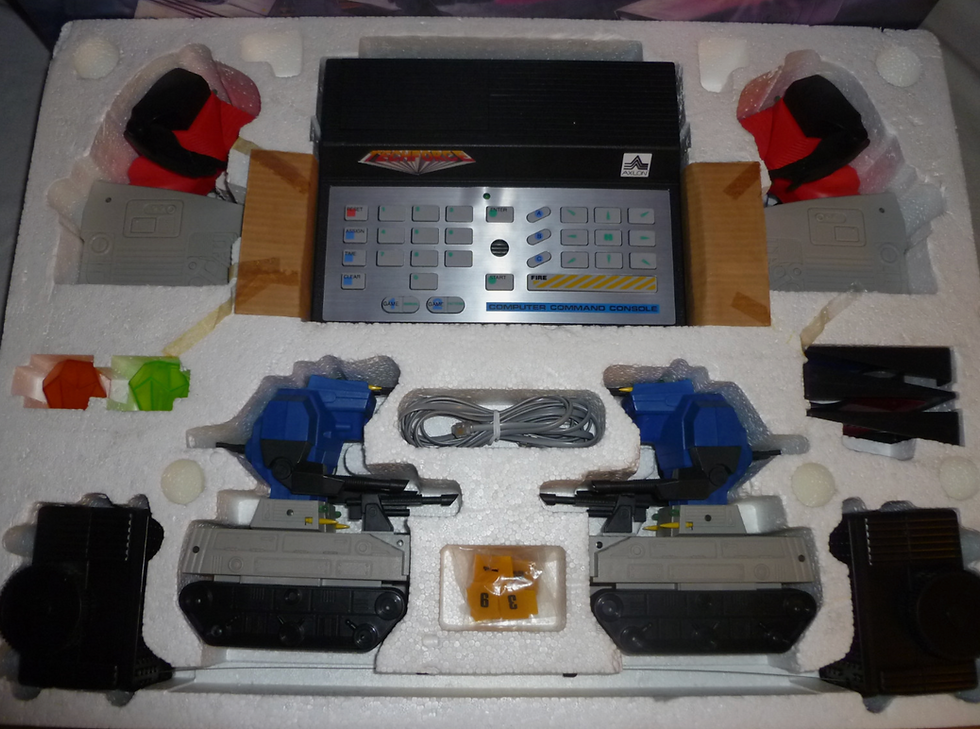The Story of Axlon: Nolan Bushnell’s “Other” Gaming Company: Part 1
- Cassie

- Jul 7
- 7 min read
Updated: Jul 7

American entrepreneur Nolan Bushnell is a legend in American video game lore. He is linked to his two most famous creations, Atari and the restaurant chain Chuck E. Cheese. These are not, however, Mr. Bushnell’s only interesting endeavors. One of the lesser known of these is Axlon, a toy company originally intended as a computer peripheral manufacture. Although the company only lasted ten years, it created a number of interesting and innovative products. Attempting to merge a toy company with a technology company, Axlon deserves it’s due in history’s spotlight.
Before Axlon
In 1972, Nolan Bushnell and Ted Dabney founded video arcade game manufacturer Atari releasing Pong and setting into motion popularizing video games for the masses. 4 years later Atari expanded into home markets by developing the Atari Video Computer System (VCS/2600) cartridge based gaming system. In time, this became Atari’s most iconic product but would cost Bushnell control of his company. Atari didn’t have the capital needed to successfully market the VCS despite early successes in the coin operated arcade market. In need of a cash flow solution Bushnell, now the sole owner of the company sold Atari to Warner Brothers for 28 million dollars in October of 1976. Adjusted for 2024 inflation, that translates to around 155 million dollars.

Bushnell was now a wealthy man, and the VCS became one of the biggest American consumer electronics products during the late 70’s and early 80’s. Atari would keep expanding finding success in the home computer market as well. Bushnell would stay with Atari mostly a figure head during the late 1970’s with control of his company quickly slipping out of his fingers.
Bushnell is an outspoken guy, and almost from the first day Warner Brothers’ executives in suits started showing up into Atari’s offices he had criticisms. Warner Brothers saw Atari’s gaming endeavors as just another product rather than a new creative art which relied upon a work atmosphere of creative support. The laid back atmosphere in which Atari was founded (Hot tubs, parties, and a very casual dress code) didn’t fly with Warner Brothers executives who brought in a corporate attitude and expected compliance with business norms. The fiction between Bushnell and Warner came to a head in 1978 when he was “mutually” fired from Atari.

Bushnell could have easily sat on his duff counting his money for the rest of his days. However, he was far from done innovating the video game industry or consumer electronics. Soon he was dipping his hands into a number of companies during the 1980’s. Bushnell’s best known venture post-Atari is the animatronic hosted family pizza restaurant and arcade chain known as Chuck E. Cheese. Much like Atari, it had its share of ups and downs but became a iconic brand for many decades.
Axlon’s Beginnings

Axlon was founded by former Atari product manager John Vurich on April 1st, 1980, with Nolan Bushnell coming aboard the company one year later (1). Bushnell’s involvement was part of his venture capital startup firm Catalyst Technologies Venture Capital Group. Vurich and Bushnell met at Atari when Bushnell took an interest in Vurich’s work on computerized pinball machines. Vurich had some pretty innovative ideas from a forward thinking “electronic wallet” and a somewhat more far fetched “flying motorcycle with wings”. Axlon’s first products would be a little more down to earth.

Axlon jumped upon opportunities in the robust home computer market during the early 1980’s with memory add-ons. Vurich stated in an interview to the Arizona Republic in 1982 that “microcomputers are limited by their memory, not the processor that is the heart of the machine” (2). As the home computer industry gained popularity during this era a marketplace developed for 3rd party hardware. Axlon sold add-on memory modules both for Atari 8-bit series and Apple II series computers. By 1982 this would include an external device named RAMdisk 320 which offered an additional 320K to the Apple II and Apple III computer systems (using data bank switching). This was an extraordinary improvement in the amount of memory for a personal computer during this era. This power wasn’t cheap however, at $1395 in 1982 dollars and the expense limited them to mostly corporate usage.

One interesting early Axlon product is the Datalink 1000 handheld computer. Datalink was marketed as a handheld telecommunication terminal capable of transmitting and receiving data over standard land phone lines via early BBS services such as CompuServe. You could theoretically check stocks, news, or make airline reservations with the small device. It included a tiny keyboard, small 16 character LED display, and the ability to operate on battery power. Datalink possibly was too ahead of its time as it would vanish from shelves almost as soon as it arrived. This was possibly due to several factors including; competition from similar devices, the limits of these devices in a pre-internet world, trouble with distribution, and the overall shakeup in the American computer market during 1983-1984. Soon after Axlon changed tactics and would shoot for shelf space at Toys R Us rather than the local computer store.
A Switch to Fun and Games
In late 1983, the decision was made to pivot Axlon from electronics peripherals to electronic toys and games. The downturn in home video game and computer markets in 1983 factored heavily into this decision. By 1983 there were seven major home gaming systems available on top of a dozen home computer options. This included offerings by toy manufactures Coleco, Milton Bradley, and Mattel. This crowding caused a saturation in the marketplace which compounded by disappointing products leading to fading consumer interest leading and a economic downturn market wide.

Bushnell stated in an 1985 interview for The MacNeil/Lehrer NewsHour “that it simply made more sense to see a Silicon Valley electronics company go into toys rather than the opposite which contributed to poor results” (3) . Some of Axon’s initial toy offerings were strongly non-tech based including a line of trivia card add-ons for the popular Trivia Pursuit board game. Axlon also started selling RC trucks that were rebranded from Japanese toy companies. These early efforts were designed for quick and easy cash building allowing capital for the young company as they sought out grander ambitions.
We are the robots
Nolan Bushnell had his hands in numerous companies in his post-Atari career including a short lived personal robotics manufacture named Androbot. Hoping to ride the wave of the 1980’s personal computer boom, several companies bet on a market developing for personal robots. Dreams of robotic butlers making you a drink after a hard day at the office or walking the dog were as much fantasy then as now. The technical power needed for such a device to be effective or intuitive just didn’t exist in 1983. These robots also required ownership of expensive home computers since they had little onboard computing power of their own.

Introduced to the public at the 1983 Consumer Electronics Show the little robots created some initial buzz. The buzz wore off quickly when Androbot failed to deliver on any of the basic promises along with their expensive price tag (the most basic unit, Topo I cost $495 US dollars in 1983. The company would love over 3 million dollars in the first five months of its existence with sales of less than $50,000. (5). Axlon made a deal with Atari to sell a very basic robot named “Androman” for the popular Atari 2600 video game system, scheduled to be released in 1984. (4) When the deal fell through due to the collapse of the home video game market, the company backs another victim of the gaming crash of 83-84.

The catalyst for transforming Axlon’s technology into the toy market was likely influenced by both an attempt to recover Androbot costs and to ride a wave of toy based robots from other companies such as Tomy. A modified and less capable version of Androbot’s small “F.R.E.D.” robot was sold under Axlon as “Andy” for both the Atari 8-bit computer systems and the Commodore 64. These were not manufactured in large quantities and are quite rare today.
A small programmable stand alone toy robot named Compurobot showed up in late 1984. The toy itself is very similar to a scaled down version of the Big Trak toy by Milton Bradley, not so much a robot as a programmable motion toy. The little Compurobot in programed via a series of buttons on the toy, and included a light, and 3 different speeds of motion if it needed to scare the cat more quickly. Compurobot shares more than a passing resemblance to Vincent, from the film the Black Hole. Either Compurobot was different enough not to send lawyers from Disney into a frenzy or Compurobot didn’t sell enough to show up on anyones radar.

Compurobot was likely developed outside of the US by an Asian toy company and simply rebadged by Axlon. This little robot does have a bit of a confusing history with some variations labeled as “George: The Computer Robot” from CGL Electronic Toys in the UK. And might have been a watered down version of Compurobot II originally sold as a make-it yourself kit sold by several companies and also sold assembled by Axlon. There was also a Compurobot III featuring similar functionality as the previous versions but with a different outer shell complete with non-functional arms. There were a few more robot pals Axlon offered including Talkabot, a basic remote controlled robot toy with a built in walkie-talkie. There was also Spybot, another remote control robot with a microphone allowing you to hear what your gross big sister is talking about in the other room.

One of Axlon’s most ambitious robot offerings came in 1987 with the Tech-Force robotic battle set. These remote programmable robot toys could battle each other via small programmable computer modules. Axlon must have thought they had struck gold with Tech-Force as they were planning an animated tie-in series called “Tech-Force and the Mo-to Monsters” which would have interacted with the toys though audio cues (6). The price of the starter kit ($250) or it’s complexity might have kept the toy from reaching main stream success that Axlon was hoping for. The animated TV show never appeared on screens and planned additional action figures never populated store shelves.
Next in Part 2: Axlon has a major toy industry hits with a robot cat and a bear that won’t shut up.
(1) Chapin, D. Thinking Ahead. The San Francisco Examiner Wed, Nov 10, 1982. Page 39
(2) Burns, S.,Home computers but firms in chips. The Arizona Republic, November 18, 1982. Page 52
(3) MacNeil/Lehrer NewsHour, PBS, “Battle of the Bears:, Unknown date (Est. December 1984).
(4) Androman Press Release, Androbot, 1983.
(5) Chin, K. Robot-maker Androbot Pulls Stock Offering. InfoWorld, November, 14 1983.
(6) Robinson, T. New War Toys Stir Up Their Own Fight. The Los Angeles Times, February 10, 1987. Page 80





